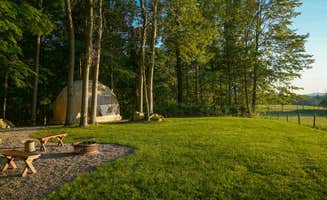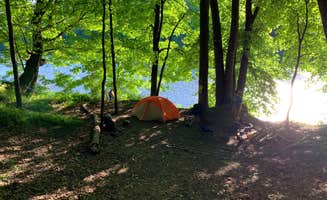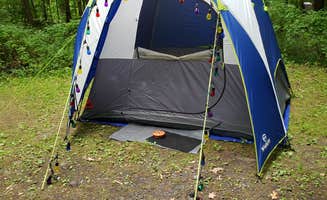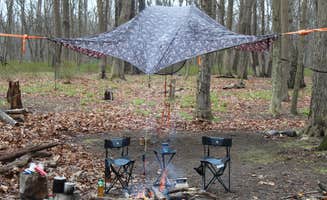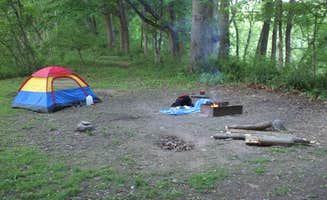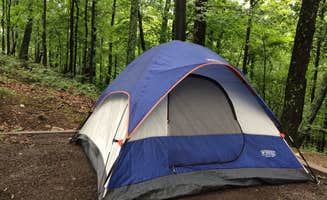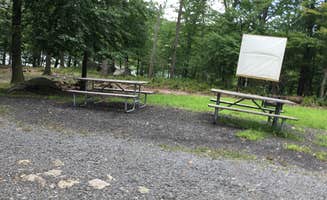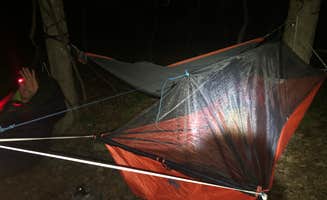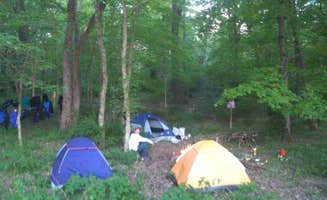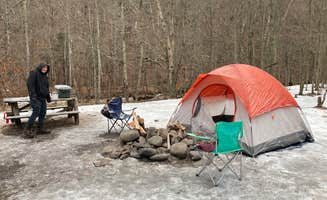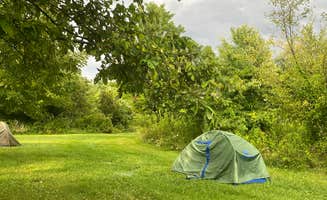Tent camping in the Delaware River region offers primitive backcountry experiences with minimal facilities. Most sites require visitors to bring all supplies and follow pack-in, pack-out principles. The island sites typically feature designated clearings with basic fire rings and pit toilets. Access to Namanock Island requires canoes or kayaks as it's a boat-in only destination, making it suitable for river trip itineraries. Sites throughout the region connect to extensive trail networks including the Appalachian Trail, with many campsites positioned to balance trail access with wilderness seclusion.
What to do
Paddle to island campsites: Namanock Island provides a completely isolated camping experience about 4 miles down the Delaware River from Milford Beach. "Namanock Island is only accessible by water... I have now taken my packraft to the island twice and have had a fantastic trip each time! The sites are maintained by the NPS and are available on a first come first served basis," reports Derek W. The river journey offers opportunities to view wildlife and experience the Delaware's gentle flow.
Visit local waterfalls: From the Sandyston Boat In Campsites, campers can reach several noteworthy waterfalls. "Within minutes on the Pennsylvania side of the river you can hike to Raymondskill Falls, (one of many in easy walking distance), as well as search for abandoned/forgotten homes and mills, (some of which date back to the 1700's), or try your luck at fossil and artifact hunting," notes John B. Dingman's Falls is also accessible via trails near the boat access point.
Explore historic sites: The Delaware River corridor contains significant historical locations. "This area is rich in history, folklore, legends and locations that anyone camping here would truly enjoy knowing/seeing," says one camper about the region. The older couple working at Dingman's Ferry bridge toll "enjoy sharing tons of history with those interested, and it's a very interesting area that has a history of over 300 years."
What campers like
Complete darkness for stargazing: Without artificial light sources, the night sky becomes extraordinary at river campsites. At Namanock Island, "the island is situated in a way that once darkness falls there are no lights to be seen in either direction, up or down river. You are camped on the side of the island that views Pennsylvania's shore. Now, no lights means an incredible view of the night sky," explains John B. This natural darkness creates ideal conditions for astronomy enthusiasts.
Spacious riverside sites: Many campsites along the Delaware offer ample space for larger groups. "The camp site is VERY spacious, we have used 5 tents at one time here, 6 or more boats, and when you add the main campfire as well as the couple minor fires throughout the camp that were burning, there was no feel of crowding at all," notes a reviewer about Namanock Island. The Sandyston sites are described as "very large and while covered by 40+ ft trees were open enough to make you wish you brought more gear and people just because it would fit."
Natural soundscape: The continuous sound of flowing water creates a peaceful camping environment. "It's a rare thing to camp on an island and Namanock is so serene and peaceful you hear the water flowing gently all night, perfection!" writes Derek W. This natural white noise helps mask other sounds and enhances the feeling of wilderness immersion.
What you should know
Limited stay duration: National Park Service regulations restrict camping at many Delaware River sites. "People found camping at this site that are not on a river trip or that are camped at the site for longer than one day can expect to receive hefty fines from the NPS," warns John B. about Sandyston Boat In Campsites. The expectation is that these sites serve as overnight stops during multi-day river journeys rather than destination camping.
Challenging boat landings: The approach from water to campsite can be difficult at certain locations. "Due to fluctuating water levels all of the islands that are used for camping have a cut wall cliff style approach, but these sites have a very steep and above average height to the shoreline making unloading both more tiring and more of a hazard than I prefer," notes a reviewer about Sandyston. Water levels vary seasonally, with spring typically bringing higher, swifter water that increases landing difficulty.
Site availability concerns: During peak season, securing a campsite without a reservation can be challenging. While some reviewers note they've "not once in 6 years, (multiple trips per year), ever found anyone in the site ahead of me," others recommend arriving earlier in the day to ensure availability, particularly on weekends during summer months. The 2021 season brought changes to Namanock Island, with only "3 approved sites on the entire island, eliminating 3 or 4 smaller sites that are regularly used by the public."
Tips for camping with families
Choose accessible sites for kids: For families with children, some sites are more appropriate than others. At Steam Mill Campground, "each of the camping spots were big and outfitted with picnic benches and fire rings for cooking," making it easier to manage meal preparation with children. Sites are described as "flat, grassy, some rocks to avoid, one tree in center, large fire ring, picnic table, short walk to the pit toilet, short walk to the water spigot."
Wildlife viewing opportunities: The riverside locations offer excellent nature observation chances for children. "Lots of nature and animal sounds day and night, saw deer, doves, robins, woodpeckers, quail(?), chipmunks, squirrels, skunk(?), and heard frogs," reports Dwight D. about Steam Mill Campground. At Namanock Island, campers report seeing "tons of bald eagles flying near the site and while paddles birds playing and baby geese with their mommas!"
Prepare for bugs: Insect activity is substantial in the Delaware River valley, particularly near water. One camper at Namanock Island notes it's a "very buggy spot, LOTS of centipedes and other creatures at night, so bring a chair instead of sitting on the bench or log." Other sites closer to marshy areas report mosquitoes as a significant issue, especially in late spring and summer.
Tips from RVers
Limited RV options: Most Delaware River primitive sites cannot accommodate recreational vehicles. For small trailers, Elks Brox Memorial Park offers some possibilities, though with limitations. "I would not drive an RV in here except maybe a small type trailer," notes Gregg T., adding that "small cars stay away" warnings are overblown as his "Nissan Rogue made it in no problem. It's .8 miles in on the right."
Consider alternative cabin options: For those seeking camping comfort without hauling an RV, Sebago Cabin Camp offers basic shelter. "These cabins are VERY rustic, four walls, a cot, and a fridge. You still feel like you are 'roughing it' but with the convenience of a fridge," explains Sara P. The cabins provide a middle ground between tent camping and RV comfort, described as "a step up from cabin camping" without plumbing or heat.


